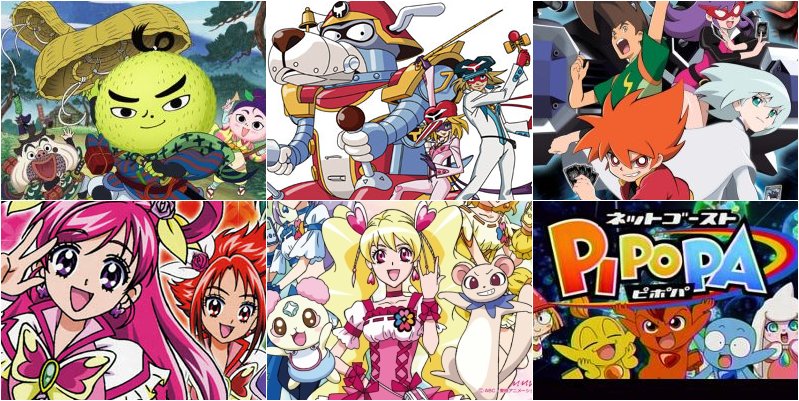
NegibÅzu no AsatarÅ, Yatterman, Battle Spirits: Shonen Toppa Bashin
Yes! Precure 5 GoGo!, Fresh Pretty Cure, Net Ghost PIPOPA
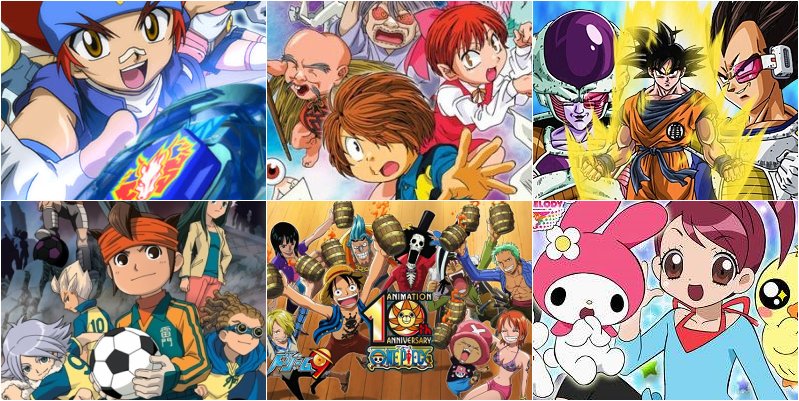
Metal Fight Beyblade, GeGeGe no Kitaro, Dragonball Kai
Inazuma Eleven, One Piece, Onegai My Melody Kirara

Jewel Pets, Zettai Karen Children, Cross Game
Live On Cardliver Kakeru, Gundam 00, Fullmetal Alchemist Brotherhood
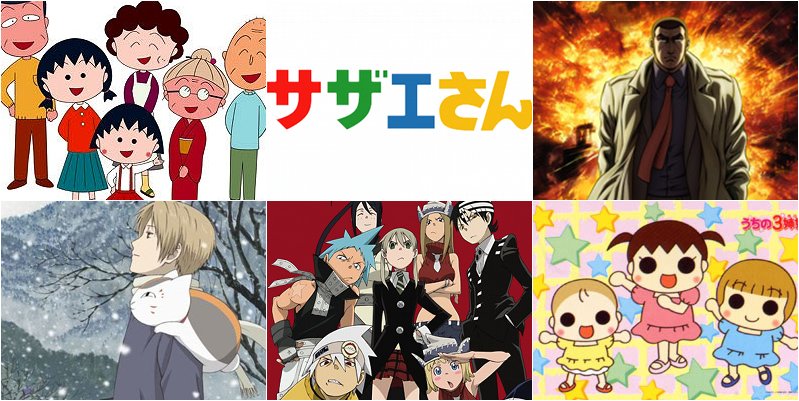
Chibi Maruko-chan, Sazae-san, Golgo 13 Best Selection
Natsume’s Book of Friends Season 2, Soul Eater, My Three Daughters

BLEACH, Naruto Shippuden, Yu-Gi-Oh 5D’s
Gintama, Kaasan – Mom’s Life, Stich!
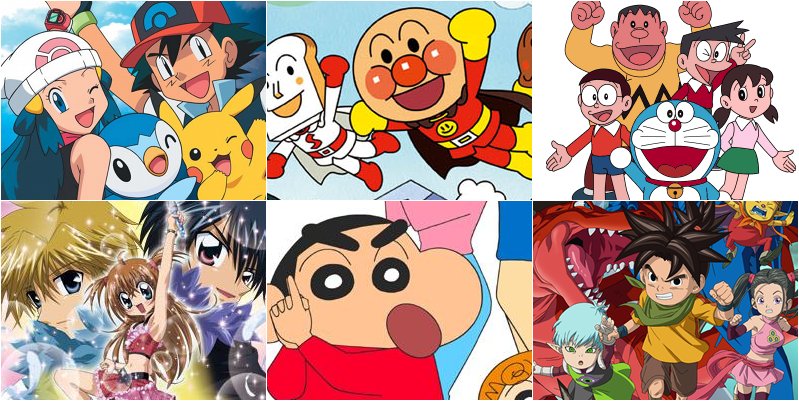
Pokemon: Diamond & Pearl, Anpanman, Doraemon
Kirarin Revolution, Crayon Shin-chan, Blue Dragon: Tenkai no Shichi Ryuu
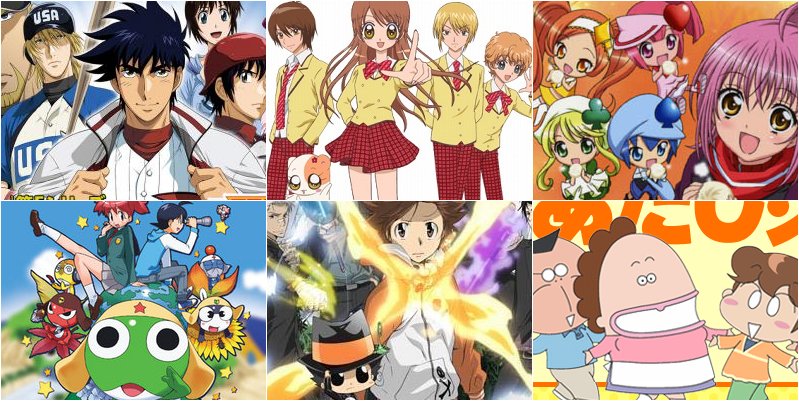
MAJOR, GokujÅ!! Mecha Mote IinchÅ, Shugo Chara
Sgt. Frog, Hitman Reborn, Atashin’chi

Detective Conan, Beast Player Erin, Shin Mazinger
Yumeiro Pâtissière, Battle Spirits: ShÅnen Gekiha Dan, Fairy Tail

Tamogotchi, Thriller Restaurant, Gokyoudai Monogatari
Letter Bee, Animal Detective Kuruminzoo
So what is my point?
Well, I wanted to illustrate that if you ignore the shows that air after midnight or on satellite, the sort of content that makes up anime on television hasn’t really changed all that much in the last 30 years. The shows up there are pretty much occupying the same slots that existed for anime before the 1997 late night boom, in some cases literally the same slots (more on that in an upcoming post).
When you are comparing the anime of today to the anime of the past, you’ve got to compare like for like and people often fail to do that. A lot of the shows that get the most fervent defenders and attackers belong to a section of the market that is less than 15 years old, so it’s spurious to compare them to shows that were never aimed at the same hardcore audience. I know I’ve done it plenty of times myself.
So what has changed?
Well there’s one big change if you compared this to a listing from the 80s – the lack of robot shows.
Despite what some writers would have you believe, robot shows haven’t been edged out by the otaku pandering shows that air late at night. Those shows are going out in time slots that were never occupied by the classic robot shows.
Robot shows were edged out by the videogame, toy and card game shows. Though there’s also an argument to be made that they simply evolved into them. The anime industry chases the money, and for over a decade now, rather than in shows that sell toy robots, the money has been in shows that follow the Pokemon formula, be that for the purposes of selling monster fightin’ videogames, collectable card games or rev-em-up vehicular beetles. This means we’re probably due a “mature”, post-modern take on Pokemon at some point in the next decade. Gird your loins for that one.
There’s been a softening of the number of literary adaptations too. In part that’s down to the World Masterpiece Theatre and its copyists hitting a malaise in 90s that ultimately lead to WMT’s demise (probably part of a general TV anime malaise in the late 80s/early 90s that I’ll get around to writing about eventually). WMT returned in 2007, but is now relegated to satellite TV.
It’s not all gloom on the literary front, the adaptation of the Thriller Restaurant books was a success in 2009 and continues to be in 2010. While light novel adaptations enjoy some success in the post-midnight slots, Beast Player Erin is the only one that made my list above. Unlike the 13/26 episode adaptations you see late at night, Erin was a old school WMT-style year long work.
It’s also worth noting the couple of late evening, pre-midnight shows that had some success in ’09. Golgo 13 Best Selection began while the original run was still airing, but at an earlier time slot. This resulted in better ratings than the first run had received. Following that we had Shin Mazinger in a similar slot, and again it was more successful than similar post-midnight shows had been. There’s clearly a market for anime targeted at men in their 40s and older, and it will be interesting to see what tries to tap that market next.
Finally on the change front – there’s a lot of TV being made. I’ve listed 53 shows up there, and even then I’ve probably missed some. Admittedly, a sizable chunk started way before 2009 and others are sequels, but even taking that into account, when I compare them to my 80s overload posts I see that there’s more shows airing now than during the years Urusei Yatsura was airing. That being said, it has possibly peaked already. Prime time slots have been lost on Sundays and Saturdays over the last decade, damaging the overall ratings for anime, again, more on that in a later post.
Otherwise, it’s pretty much the same collection of adaptations of popular shonen & shojo manga, some magical girl shows created by studios to shift merchandise (and provide contrast with the tokusatsu shows they are scheduled with) and perennial old favourites the whole family can enjoy.
Last year showed a number of titles and creators that wouldn’t look out of place in schedules decades ago. As well as the returns of Yatterman, GeGeGe no Kitaro and Dragonball, you had Zettai Karen Children (author Takashi Shiina’s Ghost Sweeper Mikami had a successful anime in 1993) and Cross Game (author Mitsuru Adachi has had anime adaptations in every decade since the 80s). Alongside that, you’ve got shows like Shin-chan, Maruko-chan, Sazae-san, Doraemon etc that literally have been in the schedules for decades plus recurring franchises like Gundam and Pokemon.
If you see a malaise in the sort of content output before midnight, then you probably need to look towards the manga industry rather than the anime industry. Even then it may be more down to changes in society and how different demographics are viewed. In the 80s, City Hunter would have been the equivalent of a Naruto or Bleach in terms of being a Shonen Jump manga turned anime, but outstripped them in success. However in the 21st Century, Tsukasa Hojo’s follow up Angel Heart is published in Comic Bunch and the anime adaptation went out in the middle of the night.
In part that’s down to writing for an audience that has grown up with you, but also due to the “me too” approach of how editors develop talent and series. Editors will be wanting the next One Piece now, but telling people to copy One Piece isn’t going to result in that, but that is what they’ll do. Additionally, there’s also the element of toning down that Daryl Surat has mentioned on Anime World Order, where the content in shonen manga is frequently a lot tamer than it was decades ago (as you may have deduced from my Violence Jack posts). That also goes for TV anime too, notoriously there was a clamp down after Evangelion on violence and sexuality that in part led to the late night and satellite anime shows that now dominate fan chatter.
I’m currently working on a couple of other follow ups to the post about what is mainstream anime, this post sprung out of them and seeing the same arguments going back and forth, again and again. In part those arguments come from the fact that much of Anglophone fandom has a view of anime that’s shot through the prisms of DVDs, streaming and fansubs. That removes any idea of how the show was originally marketed, who the audience it is intended for is and most of all having a reliance on a small number of gatekeepers of taste. This post won’t put a stop to those arguments but it’s part of shoring up some critical thinking on my part and how I approach anime criticism. And it might help drive home the point that anime doesn’t end where the internet chatter ends.
The main post I’m working on at the moment is an analysis of the Sunday anime schedules over the last 10 years, but I’ve also just started an overview of late night anime since 97, and seeing if there are discernible trends. The main trend I’ve decided on so far is that a lot of people scheduling anime late at night do so seemingly without rhyme or reason. Just look at what previously aired in the time slot Durarara!! currently occupies:
- Big Windup! Season 2
- Umi Monogatari ~Anata ga Ite Kureta Koto~
- Sengoku Basara
- Linebarrels of Iron
- Itazura na Kiss
- Noramimi
- ULTRASEVEN X
- Romeo x Juliet
- The Galaxy Railways: Eternal Divergence
- Witchblade
Are they really expecting the same audience for each of those shows? After looking at this and what works during the Sunday daytime slots, I’m increasingly of the opinion that part of the noitaminA slot’s success is due to the fact the scheduler has a specific audience in mind for that time slot.
Anyway, I’ve rambled enough, more on all of that another time!
I am super interested in that post on the late-80’s/early-90’s malaise. I was looking at all the stuff I’d watched at MyAnimeList and noticed a big gap in that period in shows that I was giving good ratings too, and then when I looked through the calendars at places like anidb for the period of like 1989-1993 there were something like 3 shows that I hadn’t seen yet that actually looked like they were of any interest to me whatsoever.
It hit me last year when I had to run a panel at short notice and was going to do one to tie into when UK anime conventions had started, and it struck me there was very little interesting to talk about during the early nineties.
My theory is that first talent and then money drained out of television to OAVs, movies and then just down the drain. You still had Kitty funding some good looking TV shows, but in the long run that did them in and left Studio Deen as a production studio whose work now generally looks worse than it did 25 years ago.
This means we’re probably due a “matureâ€, post-modern take on Pokemon at some point in the next decade. Gird your loins for that one.
Loins are girded yet slightly tingly in anticipation…
That already sort-of happened with Narutaru. Unfortunately, it was scripted by Chiaki Konaka, so it ended up being completely impenetrable…
Are the schedules available for perusing online in Japanese (and if yes where)?
http://www.geocities.jp/animesityouritu/ keeps a record of terrestrial schedules and ratings.
Alex – as it notes on the bottom of the page, though, it’s important to remember that the times and ratings are only for the Kanto area
card games are my favorite past time when not surfing the net ;;
Great beat ! I would like to apprentice at the same time as you amend your website, how could i subscribe for a weblog web site? The account helped me a applicable deal. I have been a little bit familiar of this your broadcast provided shiny clear idea